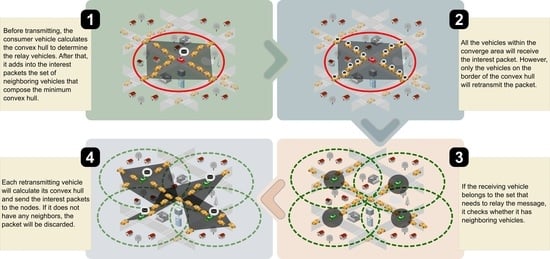Towards Improved Vehicular Information-Centric Networks by Efficient Caching Discovery
Abstract
:1. Introduction
2. Related Work
3. OVERT VNDN: Towards an Efficient Cache Discovery Protocol
3.1. Problem Formulation
3.2. Proposed VNDN Protocol Model
3.3. OVERT VNDN Operations
| Algorithm 1: Received Interest packet. |
| Input: Interest [Name, Selector(s), NONCE, transmiterVehicles] |
 |
| Algorithm 2: Received DATA packet. |
| Input: DATA [Name, MetaInfo, Content] |
 |
4. Performance Assessment
4.1. Simulation Setup
4.2. Results Assessment
5. Conclusions
Author Contributions
Funding
Conflicts of Interest
References
- Duarte, J.M.; Braun, T.; Villas, L.A. MobiVNDN: A distributed framework to support mobility in vehicular named-data networking. Ad Hoc Netw. 2019, 82, 77–90. [Google Scholar] [CrossRef]
- Immich, R.; Cerqueira, E.; Curado, M. Towards a QoE-driven mechanism for improved H.265 video delivery. In Proceedings of the Mediterranean Ad Hoc Networking Workshop (Med-Hoc-Net), Vilanova i la Geltru, Spain, 20–22 June 2016; pp. 1–8. [Google Scholar] [CrossRef]
- Silva, F.S.D.; Neto, A.V.; Maciel, D.; Castillo-Lema, J.; Silva, F.; Frosi, P.; Cerqueira, E. An Innovative Software-Defined WiNeMO Architecture for Advanced QoS-Guaranteed Mobile Service Transport. Comput. Netw. 2016, 107, 270–291. [Google Scholar] [CrossRef]
- Immich, R.; Borges, P.; Cerqueira, E.; Curado, M. QoE-driven video delivery improvement using packet loss prediction. Int. J. Parallel Emergent Distrib. Syst. 2015, 30, 478–493. [Google Scholar] [CrossRef]
- Maia, G.; Villas, L.A.; Boukerche, A.; Viana, A.C.; Aquino, A.L.L.; Loureiro, A.A.F. Data dissemination in urban Vehicular Ad hoc Networks with diverse traffic conditions. In Proceedings of the 2013 IEEE Symposium on Computers and Communications (ISCC), Split, Croatia, 7–10 July 2013; pp. 000459–000464. [Google Scholar]
- Amadeo, M.; Campolo, C.; Molinaro, A. Information-centric networking for connected vehicles: A survey and future perspectives. IEEE Commun. Mag. 2016, 54, 98–104. [Google Scholar] [CrossRef]
- Wang, Y.; Liu, H.; Huang, L.; Stankovic, J. Efficient and proactive V2V information diffusion using Named Data Networking. In Proceedings of the 2016 IEEE/ACM 24th International Symposium on Quality of Service (IWQoS), Beijing, China, 20–21 June 2016; pp. 1–10. [Google Scholar]
- Nour, B.; Sharif, K.; Li, F.; Khelifi, H.; Moungla, H. NNCP: A Named Data Network Control Protocol for IoT Applications. In Proceedings of the 2018 IEEE Conference on Standards for Communications and Networking (CSCN), Paris, France, 29–31 October 2018; pp. 1–6. [Google Scholar]
- Rondon, L.B.; da Costa, J.B.D.; Filho, G.P.R.; Villas, L.A. A Distance and Position-based Caching Discovery Protocol for Vehicular Named-Data Networks. In Proceedings of the 2019 IEEE Latin-American Conference on Communications (LATINCOM), Salvador, Brazil, 11–13 November 2019; pp. 1–6. [Google Scholar]
- Fang, C.; Yao, H.; Wang, Z.; Wu, W.; Jin, X.; Yu, F.R. A Survey of Mobile Information-Centric Networking: Research Issues and Challenges. Commun. Surv. Tutor. 2018, 20, 2353–2371. [Google Scholar] [CrossRef]
- Brennand, C.A.R.L.; de Souza, A.M.; Maia, G.; Boukerche, A.; Ramos, H.; Loureiro, A.A.F.; Villas, L.A. An intelligent transportation system for detection and control of congested roads in urban centers. In Proceedings of the 2015 IEEE Symposium on Computers and Communication (ISCC), Larnaca, Cyprus, 6–9 July 2015; pp. 663–668. [Google Scholar]
- Neto, A.J.V.; Zhao, Z.; Rodrigues, J.J.P.C.; Camboim, H.B.; Braun, T. Fog-Based Crime-Assistance in Smart IoT Transportation System. IEEE Access 2018, 6, 11101–11111. [Google Scholar] [CrossRef]
- Akabane, A.T.; Immich, R.; Madeira, E.R.M.; Villas, L.A. iMOB: An Intelligent Urban Mobility Management System Based on Vehicular Social Networks. In Proceedings of the 2018 IEEE Vehicular Networking Conference (VNC), Taipei, Taiwan, 5–7 December 2018; pp. 1–8. [Google Scholar] [CrossRef]
- Kim, M.; Kim, H.K.; Lee, S.H. A Distributed Cooperative Localization Strategy in Vehicular-to-Vehicular Networks. Sensors 2020, 20, 1413. [Google Scholar] [CrossRef] [Green Version]
- Akabane, A.T.; Immich, R.; Bittencourt, L.F.; Madeira, E.R.; Villas, L.A. Towards a distributed and infrastructure-less vehicular traffic management system. Comput. Commun. 2020, 151, 306–319. [Google Scholar] [CrossRef] [Green Version]
- An, H.; Jung, J.i. Design of a Cooperative Lane Change Protocol for a Connected and Automated Vehicle Based on an Estimation of the Communication Delay. Sensors 2018, 18, 3499. [Google Scholar] [CrossRef] [Green Version]
- Akabane, A.T.; Immich, R.; Pazzi, R.W.; Madeira, E.R.M.; Villas, L.A. Distributed Egocentric Betweenness Measure as a Vehicle Selection Mechanism in VANETs: A Performance Evaluation Study. Sensors 2018, 18, 2731. [Google Scholar] [CrossRef] [Green Version]
- Cristiani, A.L.; Immich, R.; Akabane, A.T.; Madeira, E.R.M.; Villas, L.A.; Meneguette, R.I. ATRIP: Architecture for Traffic Classification Based on Image Processing. Vehicles 2020, 2, 303–317. [Google Scholar] [CrossRef]
- Vourgidis, I.; Maglaras, L.; Alfakeeh, A.S.; Al-Bayatti, A.H.; Ferrag, M.A. Use Of Smartphones for Ensuring Vulnerable Road User Safety through Path Prediction and Early Warning: An In-Depth Review of Capabilities, Limitations and Their Applications in Cooperative Intelligent Transport Systems. Sensors 2020, 20, 997. [Google Scholar] [CrossRef] [PubMed] [Green Version]
- Hernandez-Jayo, U.; De-la Iglesia, I.; Perez, J. V-Alert: Description and Validation of a Vulnerable Road User Alert System in the Framework of a Smart City. Sensors 2015, 15, 18480–18505. [Google Scholar] [CrossRef] [Green Version]
- Immich, R.; Cerqueira, E.; Curado, M. Efficient high-resolution video delivery over VANETs. Wirel. Netw. 2018. [Google Scholar] [CrossRef]
- Gerát, J.; Sopiak, D.; Oravec, M.; Pavlovicová, J. Vehicle speed detection from camera stream using image processing methods. In Proceedings of the 2017 International Symposium ELMAR, Zadar, Croatia, 18–20 September 2017; pp. 201–204. [Google Scholar]
- Quadros, C.; Cerqueira, E.; Neto, A.; Riker, A.; Immich, R.; Curado, M. A mobile QoE Architecture for Heterogeneous Multimedia Wireless Networks. In Proceedings of the 2012 IEEE Globecom Workshops, Anaheim, CA, USA, 3–7 December 2012; pp. 1057–1061. [Google Scholar] [CrossRef]
- Colombaroni, C.; Fusco, G.; Isaenko, N. A Simulation-Optimization Method for Signal Synchronization with Bus Priority and Driver Speed Advisory to Connected Vehicles. Transp. Res. Procedia 2020, 45, 890–897. [Google Scholar] [CrossRef]
- Hussain, S.A.; Shahian Jahromi, B.; Cetin, S. Cooperative Highway Lane Merge of Connected Vehicles Using Nonlinear Model Predictive Optimal Controller. Vehicles 2020, 2, 249–266. [Google Scholar] [CrossRef] [Green Version]
- Simchon, L.; Rabinovici, R. Real-Time Implementation of Green Light Optimal Speed Advisory for Electric Vehicles. Vehicles 2020, 2, 35–54. [Google Scholar] [CrossRef] [Green Version]
- Wang, P.; Gao, S.; Li, L.; Sun, B.; Cheng, S. Obstacle Avoidance Path Planning Design for Autonomous Driving Vehicles Based on an Improved Artificial Potential Field Algorithm. Energies 2019, 12, 2342. [Google Scholar] [CrossRef] [Green Version]
- Viana, B.; Aouf, N. Distributed Cooperative Path-Planning for Autonomous Vehicles Integrating Human Driver Trajectories. In Proceedings of the 2018 International Conference on Intelligent Systems (IS), Funchal-Madeira, Portugal, 25–27 September 2018; pp. 655–661. [Google Scholar]
- Chen, C.; Seff, A.; Kornhauser, A.; Xiao, J. DeepDriving: Learning Affordance for Direct Perception in Autonomous Driving. In Proceedings of the The IEEE International Conference on Computer Vision (ICCV), Santiago, Chile, 7–13 December 2015. [Google Scholar]
- Coutinho, R.W.L.; Boukerche, A.; Loureiro, A.A.F. Design Guidelines for Information-Centric Connected and Autonomous Vehicles. IEEE Commun. Mag. 2018, 56, 85–91. [Google Scholar] [CrossRef]
- Coutinho, R.W.L.; Boukerche, A.; Yu, X. Information-Centric Strategies for Content Delivery in Intelligent Vehicular Networks. In Proceedings of the 8th ACM Symposium on Design and Analysis of Intelligent Vehicular Networks and Applications, DIVANet’18, Montreal, QC, Canada, 28 October–2 November 2018; ACM: New York, NY, USA, 2018; pp. 21–26. [Google Scholar] [CrossRef]
- Kuai, M.; Hong, X.; Yu, Q. Density-Aware Delay-Tolerant Interest Forwarding in Vehicular Named Data Networking. In Proceedings of the 2016 IEEE 84th Vehicular Technology Conference (VTC-Fall), Montreal, QC, Canada, 18–21 September 2016; pp. 1–5. [Google Scholar]
- Yu, X.; Coutinho, R.W.L.; Boukerche, A.; Loureiro, A.A.F. A distance-based interest forwarding protocol for vehicular information-centric networks. In Proceedings of the 2017 IEEE 28th Annual International Symposium on Personal, Indoor, and Mobile Radio Communications (PIMRC), Montreal, QC, Canada, 8–13 October 2017; pp. 1–5. [Google Scholar]
- Boukerche, A.; Coutinho, R.W.L.; Yu, X. LISIC: A Link Stability-Based Protocol for Vehicular Information-Centric Networks. In Proceedings of the 2017 IEEE 14th International Conference on Mobile Ad Hoc and Sensor Systems (MASS), Orlando, FL, USA, 22–25 October 2017; pp. 233–240. [Google Scholar] [CrossRef]
- De Sousa, A.M.; Araújo, F.R.C.; Sampaio, L.N. A Link-Stability-Based Interest-Forwarding Strategy For Vehicular Named Data Networks. IEEE Internet Comput. 2018, 22, 16–26. [Google Scholar] [CrossRef]
- Arsalan, A.; Rehman, R.A. Distance-Based Scheme for Broadcast Storm Mitigation in Named Software Defined Vehicular Networks (NSDVN). In Proceedings of the 2019 16th IEEE Annual Consumer Communications Networking Conference (CCNC), Las Vegas, NV, USA, 11–14 January 2019; pp. 1–4. [Google Scholar]
- Boukerche, A.; Coutinho, R.W. LoICen: A novel location-based and information-centric architecture for content distribution in vehicular networks. Ad Hoc Netw. 2019, 93, 101899. [Google Scholar] [CrossRef]
- Guo, X.; Chen, Y.; Cao, L.; Zhang, D.; Jiang, Y. A Smart Forwarding Scheme for the Interest Packet in VNDN. In Proceedings of the 2019 2nd International Conference on Hot Information-Centric Networking (HotICN), Chongqing, China, 13–15 December 2019; pp. 7–12. [Google Scholar]
- Burhan, M.; Rehman, R.A. BSMS: A Reliable Interest Forwarding Protocol for NDN based VANETs. In Proceedings of the 2020 3rd International Conference on Advancements in Computational Sciences (ICACS), Lahore, Pakistan, 17–19 February 2020; pp. 1–6. [Google Scholar]
- Graham, R.L. An efficient algorithm for determining the convex hull of a finite planar set. Inf. Process. Lett. 1972, 1, 132–133. [Google Scholar] [CrossRef]
- Costa, J.; Rosário, D.; de Souza, A.M.; Villas, L.A.; Cerqueira, E. Data Dissemination Based on Complex Networks’ Metrics for Distributed Traffic Management Systems. In Proceedings of the 2018 IEEE Symposium on Computers and Communications (ISCC), Natal, Brazil, 25–28 June 2018; pp. 01062–01067. [Google Scholar]
- Grassi, G.; Pesavento, D.; Pau, G.; Vuyyuru, R.; Wakikawa, R.; Zhang, L. VANET via Named Data Networking. In Proceedings of the 2014 IEEE Conference on Computer Communications Workshops (INFOCOM WKSHPS), Toronto, ON, Canada, 27 April–2 May 2014; pp. 410–415. [Google Scholar]
- Coutinho, R.W.L.; Boukerche, A.; Yu, X. A Novel Location-Based Content Distribution Protocol for Vehicular Named-Data Networks. In Proceedings of the 2018 IEEE Symposium on Computers and Communications (ISCC), Natal, Brazil, 25–28 June 2018; pp. 01007–01012. [Google Scholar]
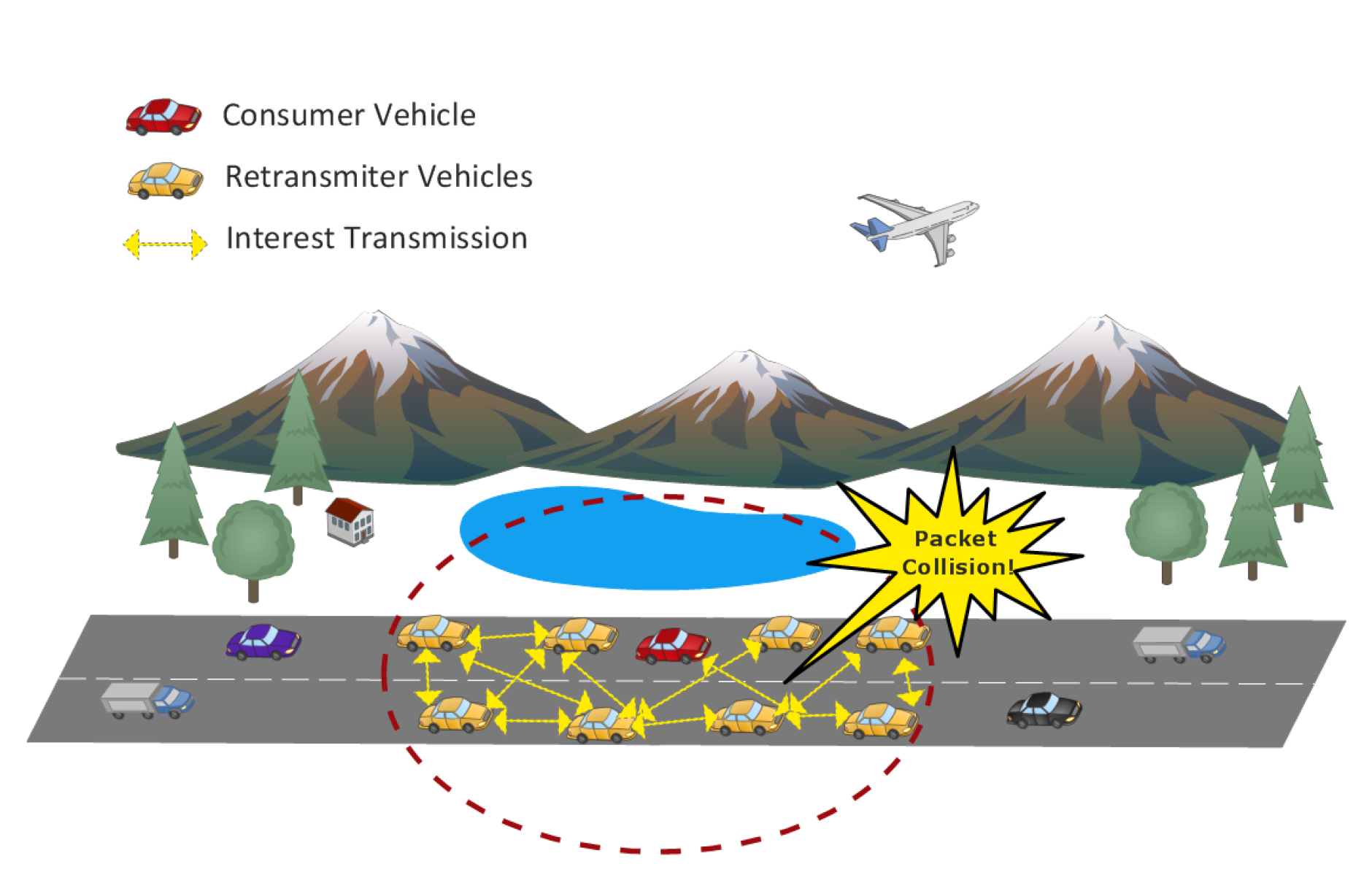
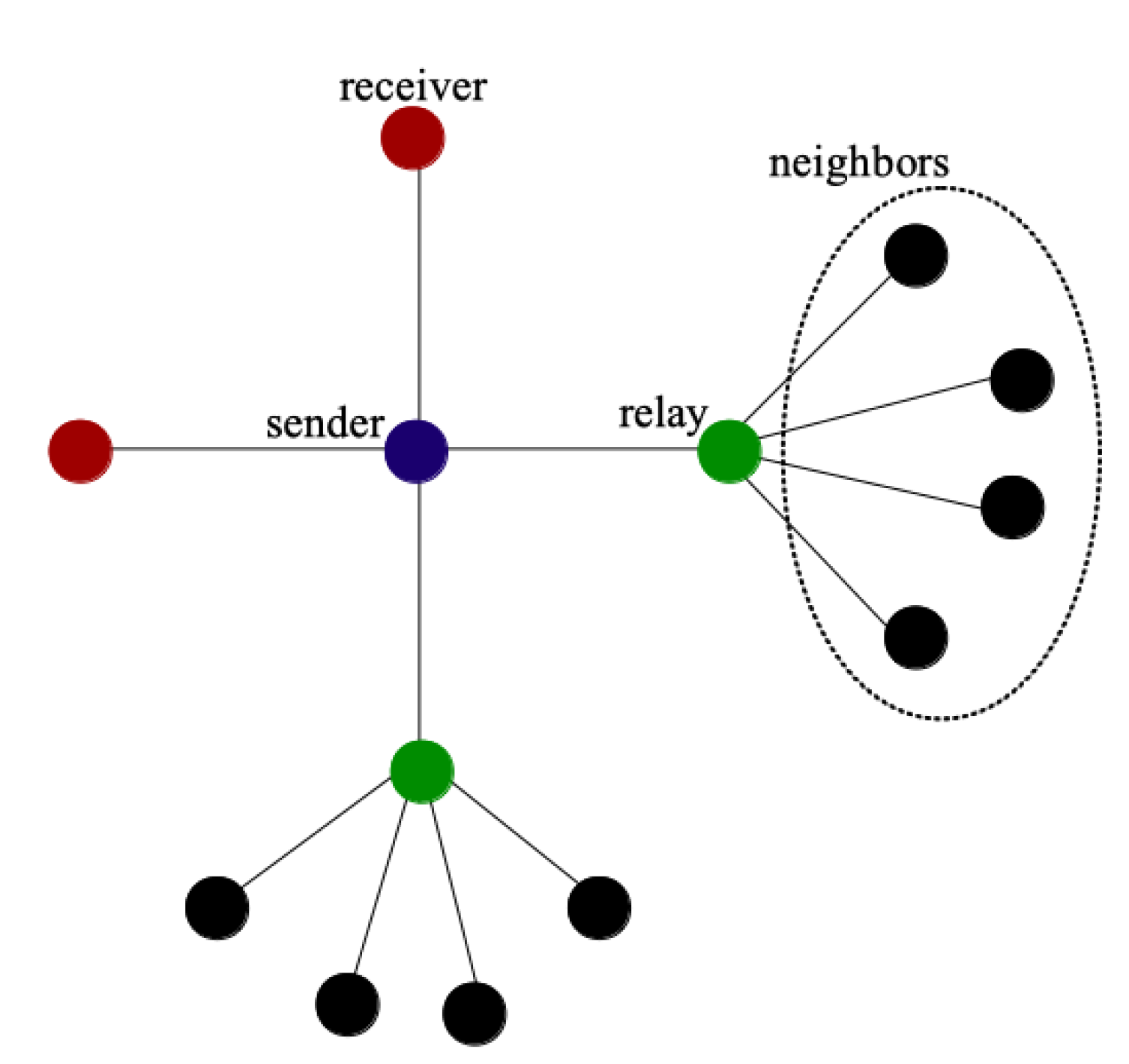
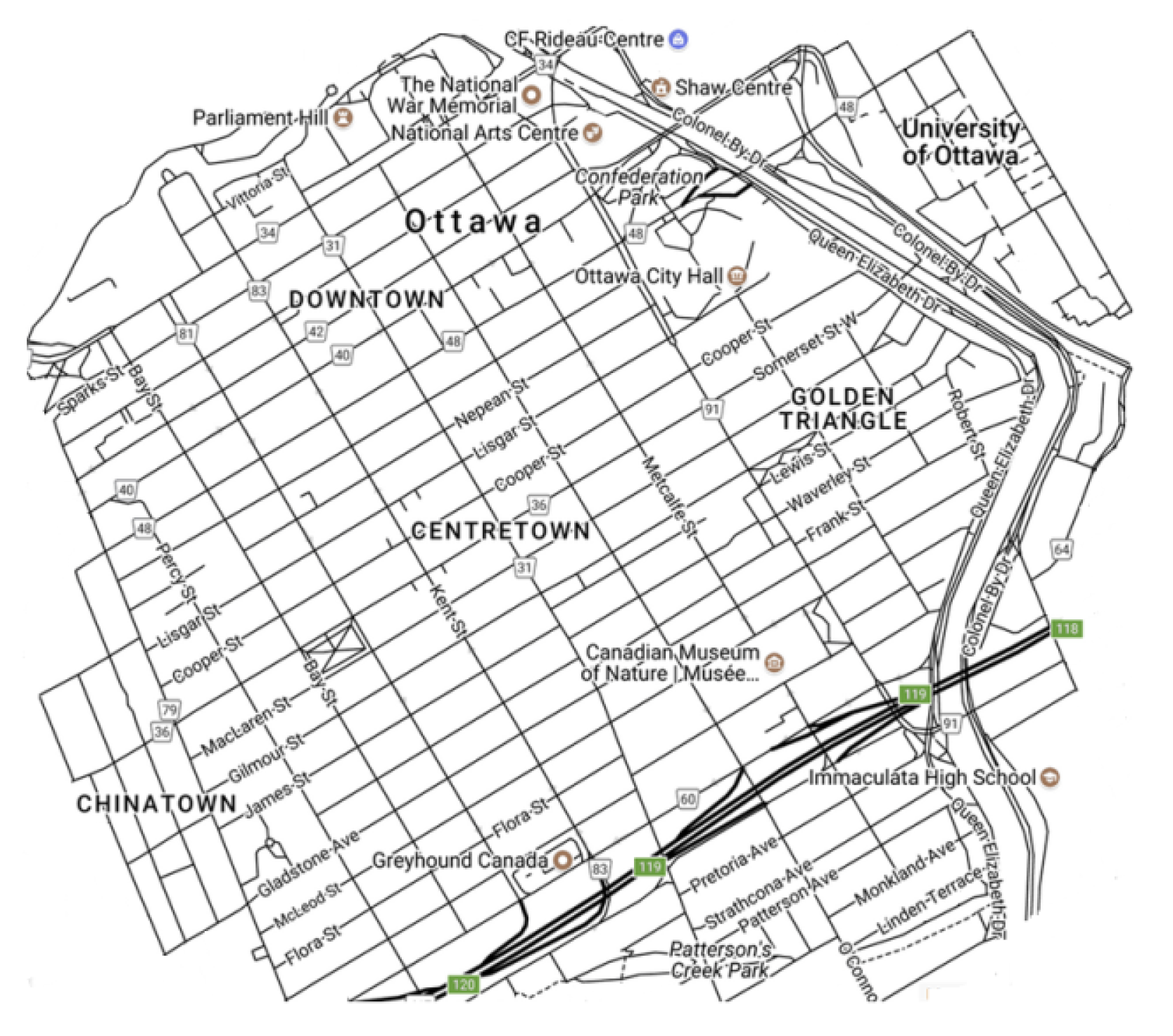



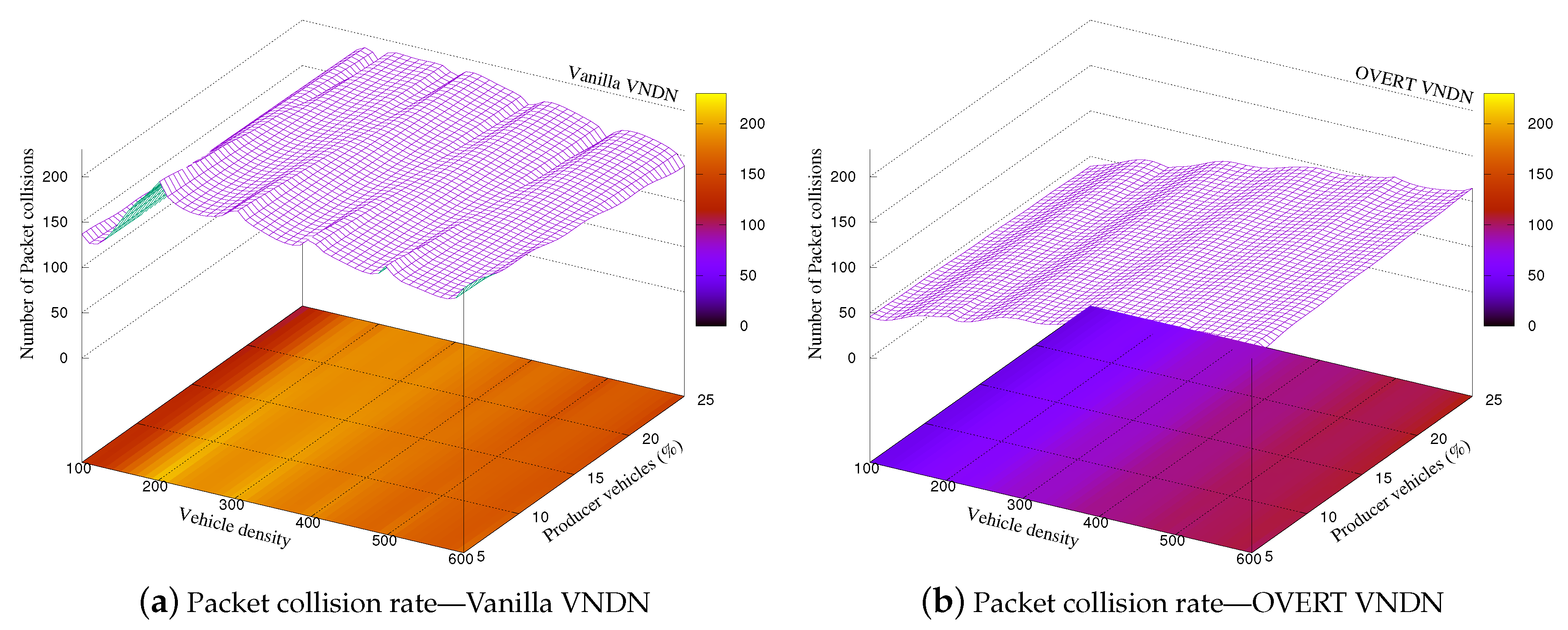
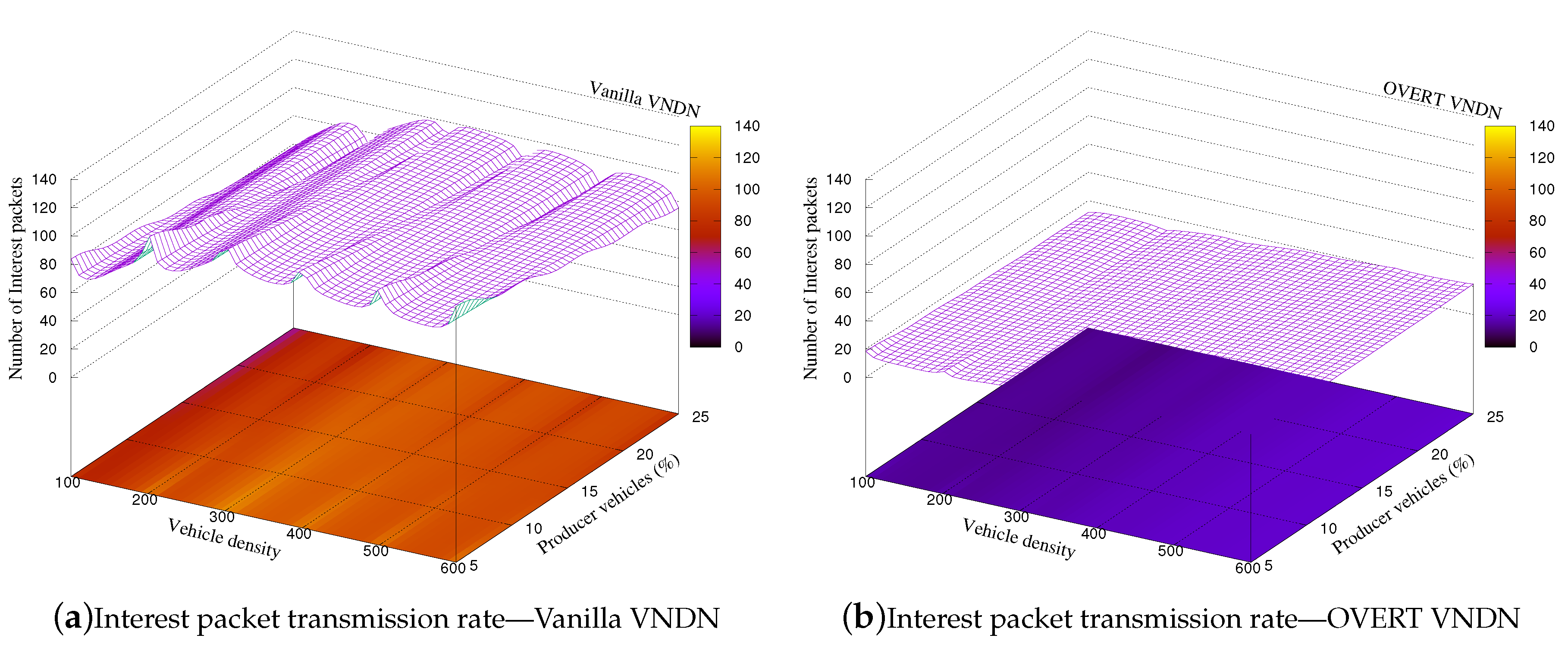
| Parameter | Value |
|---|---|
| Simulation area | Downtown Ottawa (2 km) |
| Transmission power | mW |
| Transmission range | 250 m |
| Frequency band | GHz |
| Frequency of beacons | 1 Hz |
| Communication technology | IEEE 802.11p |
| MAC | IEEE 1609.4 |
| Bit rate | 6 Mbps |
| Data packet size | 8192 bit |
| Interest packet size | 400 bit |
| Interest timeout | 15 s |
| Number of chunks | 10 |
| Interest lifetime | 25 s |
| Executions | 33 |
| Number of consumers (%) | 30 |
| Number of producers (%) | 5, 10, 15, 20, 25 |
| Simulation time | 350 s |
© 2020 by the authors. Licensee MDPI, Basel, Switzerland. This article is an open access article distributed under the terms and conditions of the Creative Commons Attribution (CC BY) license (http://creativecommons.org/licenses/by/4.0/).
Share and Cite
Rondon, L.B.; Immich, R.; Filho, G.P.R.; Venâncio Neto, A.; Leone Maciel Peixoto, M.; Villas, L.A. Towards Improved Vehicular Information-Centric Networks by Efficient Caching Discovery. Vehicles 2020, 2, 453-467. https://0-doi-org.brum.beds.ac.uk/10.3390/vehicles2030025
Rondon LB, Immich R, Filho GPR, Venâncio Neto A, Leone Maciel Peixoto M, Villas LA. Towards Improved Vehicular Information-Centric Networks by Efficient Caching Discovery. Vehicles. 2020; 2(3):453-467. https://0-doi-org.brum.beds.ac.uk/10.3390/vehicles2030025
Chicago/Turabian StyleRondon, Lucas B., Roger Immich, Geraldo P. Rocha Filho, Augusto Venâncio Neto, Maycon Leone Maciel Peixoto, and Leandro A. Villas. 2020. "Towards Improved Vehicular Information-Centric Networks by Efficient Caching Discovery" Vehicles 2, no. 3: 453-467. https://0-doi-org.brum.beds.ac.uk/10.3390/vehicles2030025




